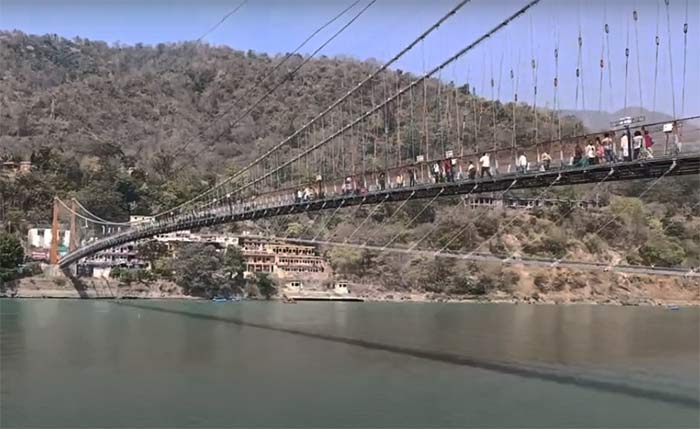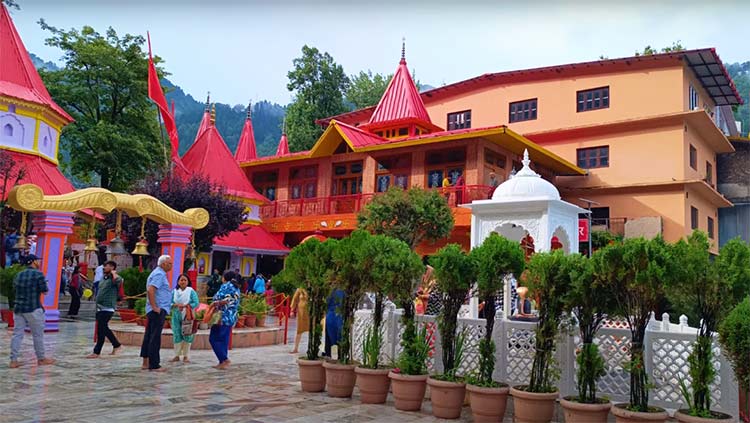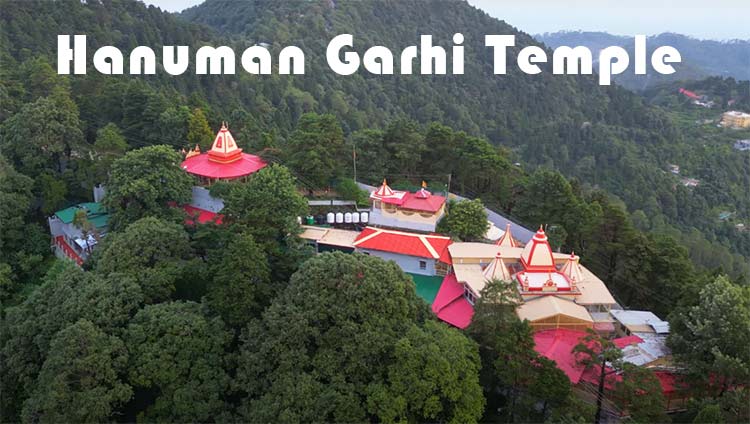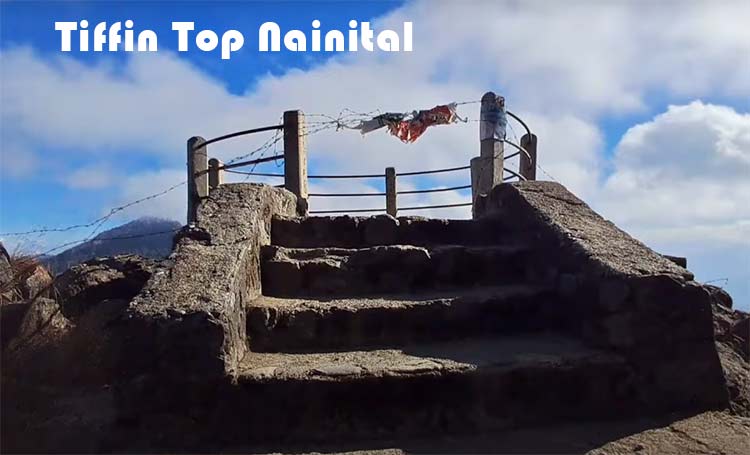Ram Jhula is a renowned landmark in the yoga capital of India, Rishikesh. This 450-foot suspension bridge is an important tourist attraction, connecting the banks of the holy Ganges river.

The bridge was initially a jute rope structure, but was later reconstructed in iron in 1986 by the Public Works Department, with significant contributions from the Sivananda Ashram.
Ram Jhula links the Shivananda Nagar area on the west bank to Swargashram on the east, allowing pedestrians and cyclists to cross the river. It offers stunning views of the Ganges and the surrounding Himalayan mountains.
Many renowned ashrams and temples, such as Parmarth Niketan, Gita Bhawan, and Neelkanth Mahadev, are located near Ram Jhula, making it a hub of spiritual and religious activity.
Visitors can explore these sites, shop at the local markets, and witness the daily Ganga Aarti ceremony on the riverbanks.
Whether you’re a pilgrim or a nature lover, Ram Jhula is a must-visit destination in Rishikesh, offering a unique blend of spirituality, adventure, and scenic beauty.
History of Ram Jhula
Believe it or not, the famous Ram Jhula bridge wasn’t always made of iron. Back in the day, it was a whole different beast. Imagine a bridge made of very strong jute ropes, tightly woven together to hold its shape and support the weight of people crossing. Pretty cool, right? And guess what? It didn’t even have any pillars for support in the beginning.
Of course, things change, and for extra sturdiness, the bridge was eventually rebuilt with iron in 1986 by the PWD (Public Works Department) under government supervision. But that doesn’t take away from its interesting history.
The name Ram Jhula itself is a nod to the spiritual significance of Rishikesh. It’s named after Lord Rama, the hero of the epic Ramayana. There’s a connection to another famous bridge nearby called Lakshman Jhula. According to legend, during Rama’s reign, his brother Lakshmana crossed the Ganges River using just two ropes.
To honor this story and the strong bond between the brothers, the Lakshman Jhula was built with ropes back in 1889. So, the Ram Jhula, named after Rama, serves as a symbol of their special connection. Pretty neat, huh?
About Ram Jhula Market
So, with all the tourists visiting Ram Jhula, a big market has popped up at each end of the bridge. It’s like a treasure chest filled with everything you could ever want!
Need groceries or travel supplies? No worries! The market has everything you need for your trip. But that’s not all! This market is a great place for souvenir hunters or anyone who wants a special memory of Rishikesh.
Feeling spiritual? Check out the stalls packed with beautiful statues, pictures, and jewelry of different gods and goddesses. They’re perfect if you’re looking for a religious token.
Want something unique and handmade? You’re in luck! The market has a charming collection of crafts made by local people. There’s something for everyone, from detailed pieces to bright and colorful items.
Need new clothes? The market has you covered too! You’ll find a sea of comfortable and colorful cotton clothes like sarees, lehengas, and cholis. They’re not only stylish, but they’re also surprisingly affordable.
And for those who love sparkly things, there’s a hidden gem waiting to be found! You can find stalls selling real, semi-precious stones and gems at great prices. So, whether you’re looking for a special piece of jewelry or a unique gift, keep your eyes peeled for these treasures.
The Ram Jhula Market is like a one-stop shop for everything you could want or need. You can find practical things, fun souvenirs, and even a little piece of something spiritual. So take your time, wander around, and see what amazing things you can find!
How To Reach
Latitude – 30.1238° N, Longitude – 78.3141° E
Address – Ram Jhula Rishikesh, Swarg Ashram, Rishikesh, Uttarakhand, 249137, India
Here are some easy ways to reach Ram Jhula:
Train: Take a train to Rishikesh Railway Station. From there, grab an auto rickshaw to get to the bridge.
Plane: Fly into Jolly Grant Airport in Dehradun (about 22 km away). Taxis are waiting outside the airport to take you to Ram Jhula – expect to pay around INR 1,500.
Bus: Catch a bus from the airport or Haridwar (more budget-friendly) to Rishikesh. Once in town, rickshaws and autos are readily available to take you to Ram Jhula.
When to Visit Ram Jhula: Sunshine or Serenity?
Ram Jhula is beautiful year-round, but the weather can vary depending on the season. Here’s a breakdown to help you choose the perfect time for your trip:
Lovely weather (February to May): This is the sweet spot for enjoying the scenery and peaceful vibes. Think sunshine, cool breezes, and comfortable temperatures.
Year-round visits: The good news is you can actually visit Ram Jhula anytime because of its location near the Ganges River and the Himalayas.
Steer clear of summer heat (June to August): Things can get hot and dry, with temperatures reaching up to 40°C (104°F). Not ideal for sightseeing sweaty!
Winters are delightful: If you prefer cooler weather, winter is a great choice. It’s perfect for exploring the area without getting too hot.
Avoid the monsoon season (June to September): Heavy rains can make sightseeing and activities like river rafting tricky. Plus, the roads can get slippery, making trekking dangerous.
The Takeaway:
The best time to visit Ram Jhula depends on what you’re looking for. If you want pleasant weather and beautiful views, February to May is your best bet. If you don’t mind the heat, any time of year can work, just be prepared for the rain during monsoon season. No matter when you choose to go, Ram Jhula promises a unique and memorable experience!
Finding Your Perfect Place to Stay near Ram Jhula
Rishikesh, a holy city nestled in the foothills of the Himalayas, attracts a multitude of visitors each year. Thanks to this, there’s a vast selection of hotels, resorts, and inns to suit all budgets and preferences. If you’re planning a trip to Ram Jhula, here are a few great places to stay nearby:
Luxury Experience (Starting from INR 6,500 per night):
Aloha on Ganges. This swanky 3-star hotel caters to a variety of tastes. Choose from a cozy tent for a unique experience, or opt for a luxurious room with a plush double or single bed, depending on your needs. They have an in-house restaurant for your convenience, and they even organize exciting activities like campfires and river rafting adventures! So, if you’re looking to splurge and have some fun, Aloha on Ganges could be your perfect match.
Mid-Range Comfort (Starting from INR 2,000 per night):
Rishabh Resort. This 2-star hotel, situated near Lakshman Jhula, boasts stunning views of the majestic Ganges River. The rooms are spacious and well-furnished, offering a comfortable retreat after a day of exploring. Feeling adventurous? Rishabh Resort can arrange activities like trekking and river rafting for you. They also have special halls dedicated to yoga and meditation for those seeking inner peace. And if you’re a foodie, you’ll love their multi-cuisine restaurant serving a delicious array of Indian, Chinese, and Continental dishes. With prices starting at INR 2,000 per night, Rishabh Resort provides a great balance between comfort, affordability, and exciting experiences.
Budget-Friendly Stay (Starting from INR 2,100 per night):
The Nirvana Palace. This 2-star hotel prioritizes comfort and convenience for its guests. They offer a variety of room options, from luxurious suites with king-sized beds to spacious and well-furnished bedrooms, ensuring you find the perfect fit for your needs. Their in-house restaurant caters to diverse palates, serving delectable Asian, Western, and Indian cuisine. Modern amenities like free Wi-Fi and air-conditioned rooms come standard, and The Nirvana Palace even provides yoga and meditation halls for those seeking spiritual rejuvenation. Plus, with medical attention readily available on-site, you can rest easy knowing they have your well-being covered. With prices starting at INR 2,100 per night, The Nirvana Palace is a perfect choice for budget-conscious travelers who still prioritize comfort and convenience. . And the Divine resort a famous hotel is also there.
Remember, these are just a few examples, and there are many other fantastic places to stay near Ram Jhula. With a little research, you’re sure to find the perfect accommodation to match your budget and travel style. Don’t forget to book your stay in advance, especially during peak tourist seasons!
Ram Jhula Must-Knows: Tips for an Awesome Visit
Here are some handy tips to make your trip to Ram Jhula even better:
Experience the Spiritual Side: Rishikesh is a famous pilgrimage spot. Explore the yoga centers, meditation ashrams, and experience inner peace.
Catch the International Yoga Festival (March): Immerse yourself in the vibrant energy of this annual yoga celebration in March.
Witness the Evening Aarti: Don’t miss the beautiful “aarti” ceremony held every evening on the banks of the holy Ganges River.
Be Prepared: Pack your own medications and a reusable water bottle for convenience.
Dress for the Season: Winters can be chilly, so pack some warm clothes no matter when you visit.
Traveling with Kids? Keep a close eye on them due to the crowds, especially during peak season.
FAQ
Ram Jhula is a renowned 450-foot suspension bridge in Rishikesh, a major tourist attraction and landmark in the “Yoga Capital of India.”
- Take in the breathtaking views of the Ganges and Himalayas.
- Explore nearby spiritual centers like ashrams and temples.
- Find souvenirs, religious items, and more at the vibrant markets.
- Witness the daily Ganga Aarti ceremony on the riverbanks.
February to May offers the best weather for enjoying the scenery. You can visit year-round, but summers can be hot and monsoons bring rain.
Rishikesh has many hotels, resorts, and inns for all budgets. Luxury options, mid-range hotels, and budget-friendly choices are all available.
Pack your medications and a reusable water bottle. Dress warmly in winter, and keep a close eye on children due to crowds, especially during peak season.
You can discover additional Tourist Attractions by clicking the link below
Tourist attractions in Rishikesh



